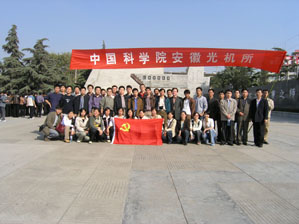
The Anhui Institute of Optics and Fine Mechanics of the Chinese Academy of Sciences' Hefei Institute of Material Science, after four years of research and development, has successfully developed an ambient atmospheric component detection system for onboard airborne components that can rapidly acquire regional environmental air pollution. The system passed the scientific and technological achievements appraisal organized by the Anhui Science and Technology Achievement Transformation Service Center.
The airborne environment atmospheric component detection system project originates from the national major science and technology infrastructure construction project—aerial remote sensing system. It is one of the ten effective detection loads in an aviation remote sensing system. It consists of an atmospheric environment laser radar, a differential absorption spectrometer, and a multi-angle polarimetric radiometer. And the main control manager consists of 4 subsystems. This achievement not only developed China's first dual-wavelength-polarized aeronautical remote sensing laser radar for detecting aerosols and clouds, and the airborne imaging differential absorption spectroscopy sub-system to fill the gap in the quantitative distribution of trace gas in airborne systems in China, but also for the detection of atmospheric and ambient air. The polarimetric polarimeter subsystem fills the gap in China's quantitative quantitative multi-angle polarimetry measurements and realizes inversion techniques for aerosol microphysical properties. It also realizes multi-angle multi-angle aerosols from ultraviolet, visible, and infrared. The combination of point, line, and plane measurements of trace gases can provide comprehensive observation methods for regional, multiple, and catastrophic measurements of atmospheric environmental pollution, and provide a quantitative understanding of the evolution of aerosol and atmospheric environmental quality in China. The microphysical properties and classification of its cognitive atmospheric aerosol provide very important technical support.
From April to May 2013, the system conducted flight tests in Tianjin and Tangshan regions. The system was integrated and operated by the master control manager and was effective in obtaining atmospheric components such as atmospheric aerosols, cloud physical properties, atmospheric components, polluting gases, and particulate matter. The information can complement each other, support each other, and jointly describe the real-time conditions of the atmosphere. The detection results are mutually verified with the data acquired by the ground instruments. The flight detection results of the 3 flights clearly show the accumulation and development trend of pollutants under different weather conditions. Reflects the ability of the system to quickly respond to the occurrence and development of pollution.
The appraisal committee believes that the data obtained from this achievement have been applied to the Institute of Remote Sensing and Digital Earth at the Chinese Academy of Sciences and the Tianjin Environmental Monitoring Center, and has achieved good social benefits. It has played a leading role in promoting the development of airborne atmospheric environmental remote sensing technology in China. . The achievements are complex, technically difficult, highly integrated, and have broad prospects for promotion. The overall level has reached the leading domestic level and internationally advanced, and they have unanimously agreed to pass the appraisal.